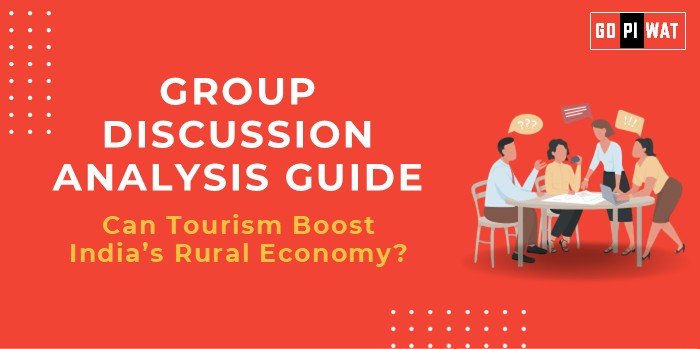📋 Group Discussion Analysis Guide
🏞️ Can Tourism Boost India’s Rural Economy?
🌐 Introduction to the Topic
Tourism is one of the fastest-growing sectors globally, contributing approximately 10% to the global GDP.
For India, known for its cultural diversity and historical landmarks, the sector holds immense potential to revitalize rural economies.
Rural tourism is emerging as a strategic tool for economic development, preserving heritage, and providing employment in rural India.
Efforts like the Swadesh Darshan Scheme and Ek Bharat Shreshtha Bharat highlight the government’s focus on leveraging tourism for rural upliftment.
📊 Quick Facts and Key Statistics
- Tourism Contribution: Tourism accounts for 5.9% of India’s GDP and 8% of employment (2023).
- Rural Population: 65% of India’s population resides in rural areas, indicating untapped potential.
- Global Comparison: France attracts over 25 million rural visitors annually, serving as a benchmark.
- Schemes for Rural Development: Swadesh Darshan (₹5,300 crore) promotes theme-based circuits.
- Employment Potential: A 10% increase in tourism could create 13.4 million jobs (World Bank Report 2022).
👥 Stakeholders and Their Roles
- Government: Implements policies, provides infrastructure, and promotes rural destinations.
- Private Sector: Invests in eco-tourism, resorts, and local enterprises.
- Local Communities: Preserve traditions, manage homestays, and offer cultural experiences.
- NGOs/International Bodies: Support sustainable tourism practices and capacity building.
🏆 Achievements and ⚠️ Challenges
Achievements:
- Swadesh Darshan: Developed 76 circuits benefiting local economies.
- Rajasthan’s Rural Fairs: Events like Pushkar attract international visitors, boosting local crafts.
- Homestay Programs: Empower rural women financially in Uttarakhand and Himachal Pradesh.
Challenges:
- Infrastructure Gaps: Poor road and internet connectivity hinder accessibility.
- Environmental Impact: Over-tourism strains resources in rural areas.
- Skill Gaps: Limited training in hospitality and management in rural areas.
🌍 Global Comparisons:
- Success: France links tourism with rural agricultural products.
- Challenges: Over-tourism in Thailand damages ecological balance.
📜 Structured Arguments for Discussion
- Supporting Stance: “Rural tourism provides employment opportunities, promotes local culture, and bridges the rural-urban economic divide.”
- Opposing Stance: “Without adequate planning, rural tourism could lead to environmental degradation and cultural commodification.”
- Balanced Perspective: “While rural tourism offers economic potential, challenges like infrastructure and environmental sustainability must be addressed.”
📖 Effective Discussion Approaches
- Opening Approaches:
- Highlight India’s unique rural diversity and its potential for tourism.
- Mention statistics on rural tourism’s economic benefits.
- Counter-Argument Handling:
- “While over-tourism is a concern, adopting eco-tourism models like Kerala’s ensures sustainable growth.”
📊 Strategic Analysis (SWOT)
- Strengths: Rich cultural heritage, diverse ecosystems, and government schemes.
- Weaknesses: Poor infrastructure, lack of awareness.
- Opportunities: Increased global interest in authentic travel experiences, eco-tourism.
- Threats: Environmental degradation, lack of private investment.
🎓 Connecting with B-School Applications
- Real-World Applications: Integrating rural tourism themes into projects on sustainable development or entrepreneurship.
- Sample Interview Questions:
- “How can rural tourism address India’s unemployment challenges?”
- “Discuss the role of public-private partnerships in promoting rural tourism.”
- Insights for B-School Students:
- Explore rural tourism as a model for inclusive growth.
- Analyze rural tourism’s role in bridging economic disparities.


